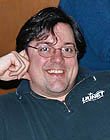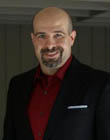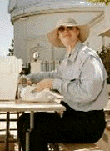|
|
 
|
|
Author
|
Topic: I'm looking for images to demonstrate proper framing
|
|
|
David E. Nedrow
Master Film Handler

Posts: 368
From: Columbus, OH, USA
Registered: Oct 2008
|
 posted 08-02-2009 09:05 AM
posted 08-02-2009 09:05 AM





I know this doesn't help you now, but if anyone has access to a 35mm print of Hitchcock's "North by Northwest", there's a lot there.
They showed this a couple of years ago at the Ohio Theatre in Columbus, OH. Unfortunately, the projectionist looked at the frame, saw it wasn't scope but did fill the entire 35mm frame, and ran it 1.33. No amount of begging and cajoling on my part could convince anyone at the theatre that it was the wrong aspect ratio.
When Thornhill is crawling around the exterior of Vandamm's house, there's a part where lighting equipment occupies a good portion of the upper-left frame area.
Later, when Thornhill, Kendall, and the Professor are in the fake redwood forest, the top of the cyclorama, including lighting trusses and possibly crew, are clearly visible, as are the flat tops of the mock trees.
There are a lot more examples in there.
Talk about one of the most frustrating experiences I've ever had as an attendee. They also ran "Animal House" 1.33, which had lots of mic booms, etc.
-David
| IP: Logged
|
|
|
|
|
|
|
|
|
|
|
|
Frank Angel
Film God

Posts: 5305
From: Brooklyn NY USA
Registered: Dec 1999
|
 posted 08-13-2009 01:47 PM
posted 08-13-2009 01:47 PM





Why is this even a question? Just as framing Scope or 1.37 is a no brainer, properly adjusting the framing position for 1.85 is a no brainer as well. The instructions to newbies is simple: YOU DON'T adjust proper framing of 1.85 by eyeballing anything on the screen -- that is not accurate enough and it's unnecessary if you are threading properly.
If you thread up the leader so that any full frame count down number, say 11 Academy any number in the SMPTE leader is in the gate and adjusted so that it is sitting framed correctly as if you were projecting scope, i.e., your framing adjustment is properly set so that your scope picture is not showing frame lines, then your 1.85 image will be exactly where it is supposed to be in the aperture. No "racking" will be needed to visually find the "center" of the frame in 1.85 where the image it left unmatted full-frame.
Occasionally a newbie might find a print where even the leader is hard matted so that might pose a problem for them if they can't find a single full, 4 sprocket high frame -- OK, just let them get another piece of film WITH full, 4 sprocket high countdown frames and thread on that -- center the framing adjustment so it is properly adjusted and then thread the hard matted film -- LEAVE THE FRAMIMG KNOB UNTOUCHED. Once it is adjusted so the intermittant is centered, there is no reason to ever move it again, asssuming no out-of-frame splices, which is a separate issue they also need instructions about.
Now if only there were a chart to make it easy to get digital aspect ratios to come out correctly on the screen!
| IP: Logged
|
|
Justin Hamaker
Film God

Posts: 2253
From: Lakeport, CA USA
Registered: Jan 2004
|
 posted 08-15-2009 05:41 AM
posted 08-15-2009 05:41 AM





I don't think I didn't really made myself clear in my initial post. This isn't really about training people to properly set/adjust the frame. The reason I'm looking for these pictures is so I can demonstrate the relationship between what's on the frame and what's on the screen, and how framing relates to what is seen on screen. In part it's so they understand what is wrong when a customer complains that they see microphones in the screen.
I think I actually use this more for the people I'm training to build-up than the people I'm teaching to thread.
When I train someone to thread, proper framing is one of the points I absolutely hammer home. "Setting the intermittent and having the sound track out when threading the projector are the two critical things...". Without actually keeping a running total, I would estimate we are out of frame at startup less than 1 in 500 showings. That works out to once every 2-3 weeks, and it's probably less frequent than that.
For what it's worth, I also teach my people to know what lens, aperture plate, and masking setting are for flat and scope. By that I mean teaching them to know by looking at the actual item, rather than just "knowing" it's the other one. I will actually take the two plates and hold them up to see if they recognize which is which.
I know all of this should be more or less standard training for anyone handling film, but we all know it's not what actually happens in the average multiplex.
| IP: Logged
|
|
|
|
|
|
|
|
|
|
All times are Central (GMT -6:00)
|
|
Powered by Infopop Corporation
UBB.classicTM
6.3.1.2
The Film-Tech Forums are designed for various members related to the cinema industry to express their opinions, viewpoints and testimonials on various products, services and events based upon speculation, personal knowledge and factual information through use, therefore all views represented here allow no liability upon the publishers of this web site and the owners of said views assume no liability for any ill will resulting from these postings. The posts made here are for educational as well as entertainment purposes and as such anyone viewing this portion of the website must accept these views as statements of the author of that opinion
and agrees to release the authors from any and all liability.
|

 Home
Home
 Products
Products
 Store
Store
 Forum
Forum
 Warehouse
Warehouse
 Contact Us
Contact Us




 Printer-friendly view of this topic
Printer-friendly view of this topic








![[Big Grin]](biggrin.gif) )
)







